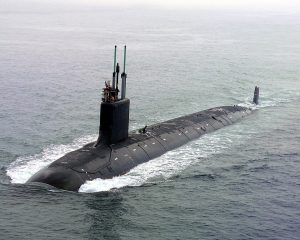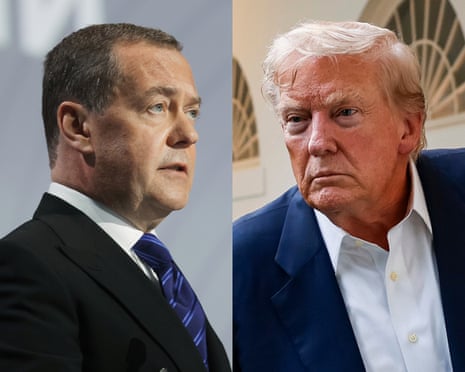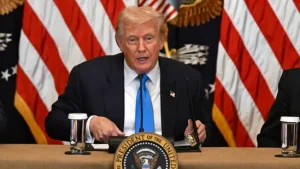Washington D.C. – President Donald Trump announced on Friday that the US Deploys Nuclear Submarines in strategic locations following what he characterized as “provocative” statements from former Russian President Dmitry Medvedev. This unprecedented military response represents a significant escalation in diplomatic tensions between the two nuclear superpowers.
The decision that the US Deploys Nuclear Submarines comes as a direct response to inflammatory rhetoric from Medvedev, who currently serves as Deputy Chairman of the Security Council of the Russian Federation. Trump’s announcement signals a shift toward more aggressive deterrence measures amid deteriorating US-Russia relations.
Strategic Positioning and Military Preparedness

Trump specified that the US Deploys Nuclear Submarines in “appropriate regions” as a precautionary measure against potential Russian aggression. This strategic positioning demonstrates America’s commitment to maintaining nuclear deterrence capabilities while responding to perceived threats from Russian leadership.
The announcement that the US Deploys Nuclear Submarines reflects careful military planning designed to counter Russian provocations without triggering immediate conflict. These submarine deployments serve as both defensive measures and clear signals of American resolve in the face of escalating tensions.
Trump emphasized that the decision for the US Deploys Nuclear Submarines represents a measured response to ensure that “foolish and inflammatory statements” from Russian officials do not translate into actual military action. The strategic placement of these nuclear assets underscores the gravity with which the administration views current threats.
Medvedev’s Provocative Social Media Campaign


The catalyst for the US Deploys Nuclear Submarines decision stems from Medvedev’s recent social media posts accusing Trump of playing an “ultimatum game” with Russia. The former Russian president’s inflammatory rhetoric escalated tensions significantly, prompting the military response.
In his provocative posts, Medvedev declared that Russia was neither “Israel or even Iran,” suggesting that Russian responses to American pressure would be fundamentally different and more severe. His statements directly challenged American foreign policy approaches and threatened consequences that motivated the US Deploys Nuclear Submarines response.
Medvedev further escalated tensions by claiming that “each new ultimatum” from Trump would be interpreted as “a threat and a step towards war.” These statements created the security environment that necessitated the US Deploys Nuclear Submarines deployment as a deterrent measure.
Presidential Warning and Diplomatic Escalation
Prior to announcing that the US Deploys Nuclear Submarines, Trump issued a direct warning to Medvedev through his Truth Social platform. The President characterized Medvedev as the “failed former President of Russia, who thinks he’s still President” and warned him to “watch his words.”


Trump’s warning that Medvedev was “entering very dangerous territory” preceded the decision that the US Deploys Nuclear Submarines, indicating a deliberate escalation ladder in American responses to Russian provocations. This progression from verbal warnings to military deployments demonstrates the administration’s commitment to backing diplomatic statements with concrete action.
The President’s emphasis on the importance of words and their potential for “unintended consequences” provides context for why the US Deploys Nuclear Submarines in response to what might otherwise be considered mere rhetoric. This approach reflects an understanding that inflammatory statements between nuclear powers carry inherent risks.
Ukraine Conflict Context and Regional Implications
The decision that the US Deploys Nuclear Submarines occurs against the backdrop of Trump’s efforts to end the three-year conflict between Russia and Ukraine. The President recently issued a 50-day deadline for both countries to reach a negotiated settlement, adding urgency to current diplomatic tensions.
Trump’s previous threats of increased sanctions against Russia and its allies provide additional context for why the US Deploys Nuclear Submarines represents an escalation in pressure tactics. These military deployments complement economic and diplomatic measures already employed against Russian interests.
The positioning where the US Deploys Nuclear Submarines sends clear signals about American commitment to supporting Ukrainian sovereignty while deterring further Russian aggression. These deployments serve multiple strategic purposes within the broader conflict resolution framework.
Nuclear Deterrence Strategy and Global Implications
The announcement that the US Deploys Nuclear Submarines reflects traditional nuclear deterrence theory, where visible military capabilities serve to prevent conflict rather than initiate it. This strategic approach aims to demonstrate resolve while maintaining stability through strength.
Also Read: Trump Executive Order On Reciprocal Tariffs: Bold 41% Import Duties Imposed
The decision that the US Deploys Nuclear Submarines also sends messages to other global actors about American willingness to respond decisively to nuclear threats. These deployments serve broader strategic communication purposes beyond the immediate US-Russia relationship.
Risk Assessment and Conflict Prevention
Trump’s statement accompanying the announcement that the US Deploys Nuclear Submarines emphasized hopes that current tensions “will not be one of those instances” leading to unintended consequences. This careful messaging demonstrates awareness of escalation risks while maintaining deterrent credibility.


The strategic calculation behind why the US Deploys Nuclear Submarines balances demonstration of resolve against potential for misunderstanding or miscalculation. This delicate balance requires precise communication and measured responses to avoid unintended conflict escalation.
Future Implications and Strategic Outlook
The decision that the US Deploys Nuclear Submarines establishes new parameters for US-Russia interactions under the Trump administration. These deployments signal that inflammatory rhetoric will be met with concrete military responses, potentially changing diplomatic calculation frameworks.
As the US Deploys Nuclear Submarines in response to current threats, the international community watches carefully for Russian responses and potential further escalation. The effectiveness of this deterrent strategy will likely influence future crisis management approaches between nuclear powers.

